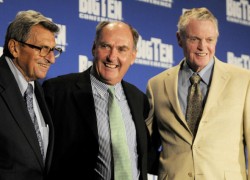
CHICAGO — The biggest news coming out of the Big Ten’s expansion to 12 teams? That there’s still more news to come.
The obvious big-ticket item at the annual Big Ten Media Days on Monday and Tuesday was the addition of Nebraska to the conference, which won’t officially happen until July 2011. But Big Ten Commissioner Jim Delany and other league officials will have plenty of logistical obstacles to overcome in the coming months, some of which he shed light on Monday.
Nebraska’s addition to the conference gives the Big Ten enough teams to institute a season-ending football championship game, but it also means the conference will have to split into two divisions, and just how the Big Ten plans to do that is a major topic of debate.
Delany said he expects to hammer out a divisional structure within the next 30 to 45 days, and that he’ll weigh competitive balance, preservation of rivalries and geography into the decision.
Calculating competitive balance could be a murky and certainly daunting task, but Delany mentioned possibly using data points like non-conference records and composite BCS rankings dating back to Penn State’s first season playing in the conference in 1993 to divide up the conference from a competitive balance standpoint.
“We moved from 95 to 85 scholarships back in those years. It was the beginning of the [Bowl] Coalition, [Bowl] Alliance, BCS Continuum,” Delany said. “And we think that’s sort of the modern Big Ten. So we’re looking at that 17-year stretch and trying to assess where institutions fall out, what they’ve accomplished and using that sort of as the basis to determine what would be a balanced and fair, competitive segmentation of divisions.”
There has been a lot of speculation on a potential Big Ten Championship game, which Delany expects to take place in December 2011, the first season with Nebraska in the conference.
It’s still unclear what site will host the lucrative game each December. Several Midwest sites, including Detroit’s Ford Field and Lucas Oil Stadium in Indianapolis, have expressed interest, and rotating the game between a few sites like the Atlantic Coast Conference and Big 12 do also appears to be a viable option.
Ohio State head coach Jim Tressel said Tuesday that he’d prefer to have the game indoors, like the Southeastern Conference does in the Georgia Dome. The Metrodome, which is interested in hosting the game, is one of three indoor sites (along with Ford Field and Lucas Oil Stadium) currently vying for the event.
Delany said that with all the Big Ten has on its plate in the coming months, he may ask the athletic directors and presidents of the conference to choose one site in 2011, and explore other potential sites in the spring.
“I just think that the selection, the philosophy, the economics around a championship venue may require more focus, more focused energy than we have right at this moment,” Delany said.
The Big Ten has kept its name despite having 11 teams for 17 years, and Delany doesn’t expect there to be any change when it adds a 12th.
“I think the Big Ten is the Big Ten regardless of the number,” Delany said.
With most of the logistical concerns falling under Delany and the league official’s jurisdiction, many of the conference coaches didn’t express a preference for how the new Big Ten should operate or how the divisions should line up. But each has their own opinion on how expansion will help the Big Ten.
Wisconsin head coach Bret Bielema said he loves the addition of Nebraska because it will increase recruiting opportunities to the West, while Illinois head coach Ron Zook said it makes the Big Ten more competitive.
But even with all the expansion speculation and hearsay over the past few months, the Big Ten may not be done stretching its borders.
Long-time Penn State head coach Joe Paterno said if the Big Ten expands further, it should look east, citing potential TV revenue and national exposure as the advantages to such a move, but admitted that it is in the hands of Delany and league officials.
“Obviously, if we decide that they’re going to — that it’s in the best interests of the Big Ten — I would hope we would be looking at a couple schools maybe in the east,” Paterno said, “because it would certainly … be a good move for us.”
Notre Dame has come up in discussion for further expansion for the Big Ten, but Delany said he is confident that they want to remain independent in football and is committed to the Big East Conference in other sports.
But the Big Ten is just six months into a 12-18 month study of expansion, and Delany has not ruled out other possibilities.
“We’ll pause but we are not necessarily turning our back on expansion,” Delany said.
